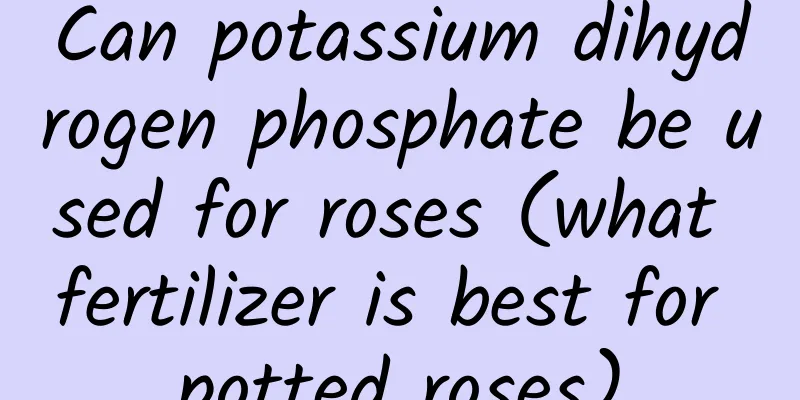Can potassium dihydrogen phosphate be used for roses (what fertilizer is best for potted roses)

Can potassium dihydrogen phosphate be used for roses?Roses can be fertilized with potassium dihydrogen phosphate, but you cannot use only potassium dihydrogen phosphate . It is definitely necessary. There are many matching schemes. This article describes how to match potassium dihydrogen phosphate one by one, so that you can use what you have and save money. Rose fertilization: compound organic fertilizer (available online and at seed stations), decomposed organic fertilizer (chicken manure, sheep manure, etc.) and quick-acting fertilizers such as potassium dihydrogen phosphate should be used together . This is because potassium dihydrogen phosphate alone has two disadvantages: ① Single fertilizer can easily cause imbalance in nutrient supplyLike other plants, roses need macroelements such as nitrogen, phosphorus, and potassium, as well as trace elements such as calcium and magnesium to grow. Potassium dihydrogen phosphate can only provide phosphorus and potassium. If other elements are deficient, for example, the roses will not be strong, and if there is a lack of iron, the leaves will turn yellow. If potted roses use potassium dihydrogen phosphate as a single fertilizer for a long time, the growth of the roses will inevitably deteriorate or even die. Roses planted in the ground will be slightly better, but they will also have unbalanced nutrition and fewer flowers. ② Potassium dihydrogen phosphate makes the soil salinizedBecause roses, especially potted plants, are prone to salinization in the soil over time, this will affect their growth. Even if watered multiple times, salinization will accumulate and destroy the soil structure. If too much phosphorus and potassium quick-acting fertilizer has been used for potted plants, it is recommended to change the soil more often to improve the soil fundamentally. How to use potassium dihydrogen phosphate in roses① Foliar fertilizer When spraying potassium dihydrogen phosphate as foliar fertilizer, try not to use it when the rose is just budding, as the tender buds can easily be burned by potassium dihydrogen phosphate. In addition, when using potassium dihydrogen phosphate as foliar fertilizer, the ratio should not be too high, generally 5/10,000 to 1/1,000 is sufficient, which is safe for tender shoots. It is best to spray the leaves when the temperature is below 25℃, before 9 am and after 6 pm, to prevent the sun from magnifying the leaves and burning them. Generally, once a week is enough. ② Root irrigation When growing roses, it is recommended to use potassium dihydrogen phosphate as root fertilization. The rose roots absorb water and phosphorus and potassium fertilizers at the same time, and the absorption effect is better than foliar fertilizers. It is also not easy to cause fertilizer damage, so it is recommended to use potassium dihydrogen phosphate for root fertilization. The general ratio is 3/1000 to 5/1000, which is a safe concentration. The concentration can be slightly higher for large seedlings and lower for small seedlings. Generally, potted plants can be irrigated once a week, and ground plants can be irrigated every time the roots are watered. For newly purchased rose seedlings, do not irrigate the roots with potassium dihydrogen phosphate within 20 days. It is more important to accelerate the growth of the seedlings. What fertilizers are best to pair with potassium dihydrogen phosphate?①Slow-release fertilizer + potassium dihydrogen phosphate Slow-release fertilizer: The release rate of chemical nutrients is much lower than the release rate of quick-soluble fertilizers converted into plant-available nutrients after being applied to the soil. Simply put, quick-acting fertilizers start to work when they are buried in flower pots and soil, and the plant roots begin to absorb them. If too much quick-acting fertilizer is used, the roots will be burned by the high concentration of fertilizers, and even the roses will die. For those who are new to potted roses or have no idea about the amount of fertilizer to use, it is recommended to use slow-release fertilizers. The nutrients in slow-release fertilizers are released slowly and are not prone to fertilizer damage. Moreover, the fertilizer effect is long-lasting and the frequency of fertilization does not need to be particularly high, which saves trouble. ②Organic fertilizer + potassium dihydrogen phosphate Now brands such as Stanley are producing organic compound fertilizers. The ratio of nitrogen, phosphorus and potassium is mostly around 1:1:1, and there are also some trace elements, so they are relatively nutritious. When cultivating roses, roses require more phosphorus and potassium fertilizers due to budding and flowering. Therefore, when using, you can bury organic fertilizers in the soil and add one or two grams of potassium dihydrogen phosphate as topdressing. ③Farmyard manure + potassium dihydrogen phosphate Farmyard manure must be decomposed fertilizer, especially for potted plants. It is generally used as base fertilizer, which has a long effect, slow effect and is safe. It must be safely separated from the root system. Small seedlings should use less base fertilizer, while large seedlings can use more. Chicken manure should be used less, as it has a stronger fertilizer effect, while sheep manure has a relatively mild fertilizer effect. These three fertilizers are generally used as base fertilizer and top dressing. Then, in daily life, you only need to irrigate the roots and spray the leaves with potassium dihydrogen phosphate after the rose leaves are a little older, before bud formation, and after flowering to meet the rose growth needs. |
>>: Can I use electrical tape for rose grafting (when should I remove the rose grafting tape)?
Recommend
How to raise Amaryllis at home
Amaryllis growing conditions The suitable tempera...
How to remedy pepper frost damage?
The temperature is lower in winter, and farmers w...
Should honeysuckle be placed in a large or small pot?
Should honeysuckle be placed in a large or small ...
The main value of gooseberries
Nutritional Value Gooseberry pulp contains multip...
The efficacy and function of Longan
1. Ornamental effect The bracts and petals of the...
What areas are suitable for growing green plum trees?
Greengage tree planting conditions The green plum...
Leaf cutting propagation method of succulent plants
Preparation for leaf cutting propagation of succu...
Can camphor trees be planted in pots?
Can camphor trees be planted in flower pots? Camp...
Cultivation methods and precautions of mulberry tree
1. Soil The mulberry tree has a strong adaptabili...
Can blue snowflakes survive if they are directly planted in the soil? Can blue snowflakes survive by cuttings?
Blue snow flower is an elegant and beautiful flow...
How to prune Wanchongshan
1. Pruning method When pruning Wan Chong Shan, ju...
How to repair the roots of the Liuli Palace
Does the Glass Palace need root repair? The Liuli...
Things to note when planting roses in summer
Summer rose blooms The characteristics of roses a...
How to slow down the growth of spider plants
Chlorophytum comosum seedling acclimatization tim...
How to grow hydroponic Guanyin more vigorously
The hydroponic Guanyin likes light and can be pla...









